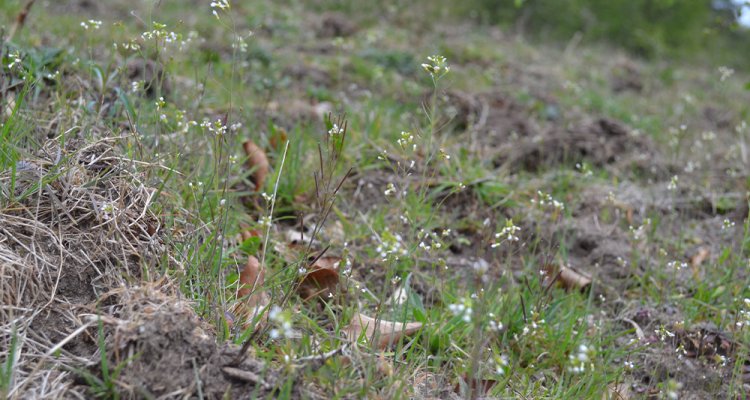
Plant architecture in relation to the environment (Willemsen Group)
Within my team we study key cellular and developmental mechanisms in plants. Our group investigates pattern formation, cell polarity, cell cycle, growth and regeneration, also in response to mutualistic microbes.
We use model, non-model and crop plants. We combine molecular genetic, genomic and biochemical approaches with bioinformatics and computational modelling of biological processes to answer relevant research questions in plant cell and developmental biology.
Below, some details on ongoing projects:
How succession shapes adaptation of natural populations of Arabidopsis thaliana
In spite of recent advances in molecular biology and ecology, we still do not understand mechanistically how plant life history strategies are shaped by environmental factors. We want to figure out how plant-soil interactions influence adaptation of these strategies. Our aim is to unravel how soil development during secondary succession influences the selection of plant life history strategies.
We are studying natural populations of Arabidopsis thaliana and how they are influenced by successional changes in biotic-abiotic soil conditions in a well-described time series of abandoned ex-arable fields. During secondary succession, the plant community shifts from pioneer to later succession species under influence of changes in both the abiotic and biotic composition of the soil. We have the hypothesis that belowground changes contribute to adaptation of plant roots to their specific soils, as roots are the interface of the plant and the soil. In this research, we are integrating soil ecology and molecular plant biology studying genomes, expression patterns, plant-soil feedback effects and root architecture. These findings will provide fundamental knowledge on root traits of crops adapted to sustainable soil management in agriculture.
- Studying the effect of soil succession on natural Arabidopsis populations
- Coupling genetic variation to soil succession to identify micro-evolution
- Investigating the role of root architecture in soil succession
Main techniques:
- Standard molecular biological tools such as DNA isolation, PCR and sequencing
- CRISPR-Cas9 mutagenesis and Golden Gate modular cloning
- Arabidopsis transformation, genotyping and phenotyping
- Confocal Laser Scanning Microscopy (CLSM)
- Analysing root systems using the rhizotron system
- Field work collecting natural Arabidopsis populations and succession soil
- Large-scale plant-soil feedback experiments
- Bioinformatics concerning Arabidopsis WGS and RNAseq as well as microbiome sequencing
Interested? Contact:
Unravelling the role of PLT transcription factors during early embryogenesis
Embryogenesis is a crucial developmental process in flowering plants. The initial asymmetric division of the plant zygote produces different apical and basal daughter cells and has been linked with differential auxin distribution but the underlying mechanism for this generation of cell fate diversity remains unknown. Expression of the PLETHORA (PLT) genes, encoding AP2 domain containing stem cell transcription factors, is detectable from the earliest stages of embryogenesis onward. Two members of these plant specific transcription factor family are crucial at the first stages of embryogenesis. The function of PLT genes in early embryogenesis will be investigated. And we will try to isolate and analyse factors which are activating these important transcription factors.
Techniques your are going to use in this project are:
- Standard molecular biological tools: (gate way)cloning, PCR, DNA isolation, sequencing, gel electrophorese, protein expression in bacteria, protein isolation, PAGE
- Yeast-one-hybrid
- Yeast-two-hybrid
- EMSA
- Confocal scanning microscopy
- In Situ Hybridisation
- Mutant analysis
- Bioinformatics
Interested? Contact:
Linking molecular biology and ecology: Investigating the role of root architecture in soil succession
In this project, we want to study the importance of root architecture for successful soil colonization thereby connecting molecular and plant developmental biology to terrestrial ecology. I am studying natural population of Arabidopsis thaliana derived from secondary succession fields. We want to test whether a specific root system architecture is optimal for growth in soils of certain succession stages. To do so, we are able to simplify and elaborate root architecture of Arabidopsis through well-established genetic and molecular knowledge. This can done by mutating lateral root, adventitious root and root cap developmental processes.
In the project, you would be involved in generating the genetic constructs needed to change the root architecture, characterization of these root architecture mutants and to actually test these plants on different succession stage soils. Additionally, you would be screening root systems of natural Arabidopsis populations coming from these succession soils and check for phenotypic differences.
Techniques you are going to use in this project are:
- Standard molecular biological tools such as DNA isolation, PCR and sequencing
- CRISPR/Cas9 mutagenesis and Golden Gate modular cloning
- Arabidopsis transformation, genotyping and phenotyping
- Confocal Laser Scanning Microscopy (CLSM)
- Analysing root systems using the rhizotron system
- Depending on season; field work collecting natural Arabidopsis populations and succession soil